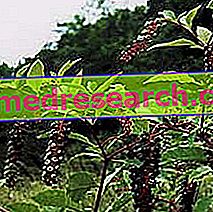
Scientific name
Phytolacca decandra
Family
Phytolaccaceae
Origin
Northern America. The phytolacca is a cultivated plant, also for ornamental purposes, which grows spontaneously even in our country.
Used Parts
The dried leaves are used as a drug for the phytolacca.
Chemical constituents
- saponins
Fitolacca in Erboristeria: Properties of Fitolacca
Phytolacca is considered a toxic plant. However, in the past dried leaves were used in decoction as a purgative.
Biological activity
As mentioned, phytolacca is considered a toxic plant due to the saponins it contains. However, it seems that the fruits of phytolacca have antiviral properties and that the roots are, instead, endowed with anti-edema and immunostimulatory activity.
However, due to the highly toxic saponins contained in it, the use of the phytolacca did not obtain official approval for any type of therapeutic indication.
Phytolacca in folk medicine and homeopathy
In the past, the phytolacca was used as a remedy for constipation, skin ulcers, rheumatic disorders, tonsillitis, pharyngitis, conjunctivitis, dyspeptic disorders and dysmenorrhea; it was even used for the treatment of worm infestations, scabies and syphilis.
Currently, phytolacca is used only in the homeopathic field, where it can be found in the form of granules, oral drops, mother tincture, capsules, tablets and ointment.
Homeopathic medicine uses this plant - alone or in association with other homeopathic remedies - for the treatment of a wide variety of disorders, such as: inflammation of the mucous membranes (especially those of the respiratory tract), pharyngitis, tonsillitis, bronchitis, disorders rheumatic, inflammation of the mammary glands, dysmenorrhea, symptoms of premenstrual syndrome (such as, for example, migraine, nervousness and nausea), infectious diseases of different origins and nature, pain associated with dentition in children and ulcers of the oral cavity.
The amount of homeopathic remedy to be taken can be different between one individual and another, also depending on the type of disorder one wants to treat and according to the type of preparation and homeopathic dilution that one intends to employ.
Side effects
Phytolacca is a toxic plant; the fruits (berries collected in bunches) are toxic, but also the leaves and roots. Their ingestion causes serious signs of saponin poisoning: nausea, vomiting, diarrhea, mydriasis and cardiovascular failure.
Contraindications
Since phytolacca is an extremely toxic plant, its intake is contraindicated in any case.
Pharmacological Interactions
- not being used in therapy because it is a toxic plant, interactions of phytolacca with other drugs are not known.



